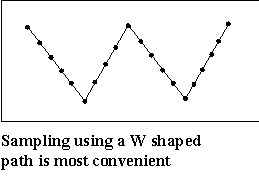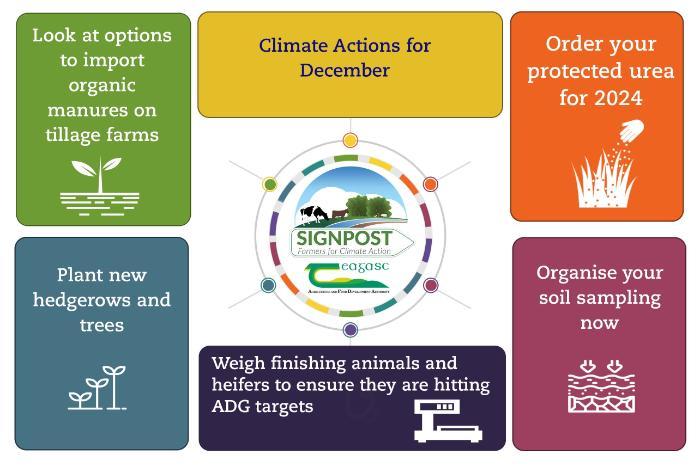Climate Actions for December
- Order you protected urea for 2024
- Organise your soil sampling now
- Weigh finishing animals and heifers to ensure they are hitting ADG targets
- Plant new hedgerows and trees
- Look at options to import organic manures on tillage farms
Protected Urea
Protected Urea is very welcomed news for Irish agriculture as it is a key technology for the sector in meeting its 25% reduction in GHG’s emissions by 2030. It is seldom that a new technology costs less and delivers major environment benefits in reducing N losses. Extensive research in Teagasc and on farm use has shown the reliability of protected urea as a very effective N fertiliser source for Irish farming conditions. It delivers consistently on yield compared to nitrate based fertilisers (CAN 27% N) while significantly reducing nitrous oxide (N₂O) a powerful GHG and ammonia (NH3) emissions thus improving the efficiency of applied fertiliser N.
Urea fertiliser is the most widely used N source in the world and protecting it with a urease inhibitor (NPBT / NPPT) firstly reduces ammonia N (NH3) losses by up to 80% thus retaining more N to better match crop N demands during the growing season. Secondly, by replacing nitrate-based fertilisers (e.g. CAN) with protected urea we reduce N₂O losses by 70%. This is a major ready to go technology in meeting out 2030 target, delivering a 3 to 8% reduction in GHG emissions on livestock farms.
Cost savings €€€!
Over the last 24 months fertiliser N prices have reach heights never seen before due to global unrest. This has resulted in a large price differential between protected urea and CAN, with urea significantly better value due to large volumes traded globally. Over the last 6 months, fertiliser prices have dropped month by month but remain high compared to pre global unrest. Average fertiliser prices to date in 2023 (table 1) show that Protected urea offers a 30% lower cost per kilo compared to CAN (27% N). Take a 50ha dairy farm applying 210kg N/ha as Protected Urea compared to 150 kg N/ha as CAN gives a saving in fertiliser N costs of €7,980.
| Table 1: Average price of fertiliser nitrogen in 2023 | |||
|---|---|---|---|
| CAN 27% | Standara Urea 46% | Protected Urea 46% | |
| Kg N/tonne | 270 | 460 | 460 |
| €/tonne | €680 | €750 | €810 |
| €/kg | €2.52 | €1.63 | €1.76 |
Retaining more effective N & Reducing N rates
Protected urea reduces N loss from 15% for standard urea to 3% thus retaining 12% more effective N. With reduced and more regulated chemical fertiliser N use, retaining more effective N in the soil allows adjustments to N rates while still maintaining yield compared to standard urea. Take an example 50ha dairy farm switching from applying 210kg N/ha as all Standard Urea to Protected Urea, N rates can be reduced by 12% equating to a reduction of 22kg N/ha giving a fertiliser farm N saving of €1,936.
Reducing farm emissions
By switching to 100% protected urea on dairy farms, total farm emissions have the potential to be reduced by 7-8% at a spreading rate of between 200 to 250 kg N / ha. The equivalent savings on total emissions on suckler farms is 1-2%, at a spreading rate of 60 to 80 kg N / ha. To achieve a 100% switch to protected urea the use of high P-K products such as 18-6-12 +S would be required to deliver balanced P, K & S nutrition. On-going research at Johnstown Castle is showing that fertiliser blends containing N with a high ratio of ammonium-N to nitrate-N (generally high P blends) are more stable and environmentally friendly. For example, the N form is 10-10-20 / 18-6-12 is mainly ammonium N resulting in a 40% reduction in N₂O emissions relative to CAN 27% N or high Nitrate – N based compounds such as 27-2.5-5 / 24-2.5-10.
More grass from less N
A long-term trial (8 years) at Johnstown Castle is consistently showing that the grass grown by protected urea has been greater than standard urea in 7 out of 8 years. Protected urea grew 13% more grass on average compared to standard urea. The additional yield is similar in magnitude to the extra effective N level delivered to the plant by protected urea over standard urea. CAN yielded 9% more than standard urea. At a time of more regulated chemical fertiliser N use moving from standard urea to protected offers the opportunity to reduce fertiliser N rates by up to 10%.
In Summary – Making the switch to Protected Urea delivers the following
- Reduce your fertiliser N costs by 30%
- Reduce N₂O & NH3 emissions by 70 and 80%, respectively
- Reduce overall farm emissions by 7 to 8%
- Fertiliser blends such as 18-6-12 reduce GHG emissions by 40%
- Reduce farm N requirements (Switch from Standard Urea to Protected Urea)
- Protected urea grows 13% more grass over standard urea
Soil Sampling
The results of a soil analysis are only as good as the sample on which it is based. To give reliable advice, a soil sample must be representative of the area sampled and be taken to a uniform depth (10cm).
The principle of soil analysis is to determine the average nutrient status of an area and to give a measure of the available nutrients in the soil. A sample normally consists of 0.25 – 0.5 kg of soil and this is taken to represent the entire sampling area or field.
- To take a soil sample it is essential to have a suitable soil corer
- Ensure soil cores are taken to the correct sampling depth of 100 mm (4”)
- Take a soil sample every 2 to 4 ha. (5-10 acres)
- Take separate samples from areas that are different in soil type, previous cropping history, slope, drainage or persistent poor yields
- Avoid any unusual spots such as old fences, ditches, drinking troughs, dung or urine patches or where fertiliser / manures or lime has been heaped or spilled in the past.
- Do not sample a field until 3 to 6 months after the last application of P and K and 2 years where lime was applied.
- Take a minimum of 20 soil cores, mix them together, and take a representative sub-sample for analysis, making sure the soil sample box is full.
- Take a representative soil sample by walking in a W shaped pattern across the sampling area.
- Sample fields at the same time of the year to aid comparisons of soil sample results and avoid sampling under extremes of soil conditions e.g. waterlogged or very dry soils.
- Place the soil sample in a soil box to avoid contamination and write the field number and advisor code on the soil box with a black permanent marker.
Soil Sampling Pattern

Weigh Finishing Animals and Heifers
Weigh finishing animals over the winter to ensure they are on target for finishing.
Invest in a weighing scales. A weighing scales is an important decision support tool, helping farmers to make decisions around performance management.
Weighing
- Make sure the scales is correctly calibrated
- Weigh finishing animals at housing and again midway through the housing period
- Weigh animals at the same time every time you weigh them. Pick a time and stick to it. Gut fill can have a significant impact on weights so always do the weighing when they are either full or empty.
- Don’t put too much emphasis on weights taken close together e.g. every month. Weighings 2-3 months apart can give a more accurate picture.
- Don’t put too much emphasis on the weight of individual animals. There will be significant variation in a group but the overall trend needs to be right.
- Take action based on the weights. Things to watch for:
- Silage quality
- Silage intake
- Supplementation rate
- Supplementation quality
- Housing – space allowance, feeding space and ventilation
- Fluke and worm dosing programme
Plant New Hedgerows and Trees
Best practice hedge planting
- Mark out the line of the new hedge using wire, twine or lime
- Cultivate with a digger or mini-digger – to make it easier to plant and give plants a great start
- Protect roots from drying out during planting by keeping plants in the bag until needed
- Plant in a double staggered row – with 330mm (just over a foot) between the rows and the same between the plants within the rows – often the length of a boot
- Plant to the same depth as was previously planted. Don’t bury the stem or expose the roots
- Firm in
- Identify a few whitethorn (maybe 5 / 100 m) to be retained as trees and protect with tree guards or shelters
- Prune all other plants except holly down to an inch or so above ground level with a sloping cut to leave a sharp point
- Push a 4 foot or 1.2m wide strip of compostable film or used silage plastic down neatly over the cut stumps.
- Press the edges of the plastic into the ground to hold it down
- Protect from livestock including rabbits if The aim is to remove that wire in a few years
For more information click here Planting Hedges
Options to Import Organic Manures on Tillage Farms
Organic manures are a valuable and cost effective source of N, P & K especially with the large increase in fertiliser prices. To maximise the recovery of N from high N manures (pig & poultry) it is important to apply and incorporate within 3 to 6 hrs. Ideally test manures in advance of application to know there nutrient values and adjust application rates to supply ~ 50% of the crops P & K requirements. For example an application of 25mᶾ/ha of pig slurry (2,200gals/ac) can supply 52kg N, 20kg P & 50kg K/ha which is ~30% of N and ~50% of P & K requirements for a crop of spring barley. Now is a good time to look at local sources of organic fertilisers and plan for spring crop utilisation.

